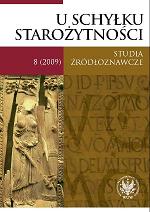JEZABEL I EUDOKSJA – DWIE KRÓLOWE. PRZYCZYNEK DO DZIEJÓW KONFLIKTU JANA CHRYZOSTOMA Z CESARZOWĄ EUDOKSJĄ
JEZEBEL AND EUDOXIA – THE TWO QUEENS. AN ADDITION TO THE HISTORY OF THE CONFLICT BETWEEN JOHN CHRYSOSTOM AND EMPRESS EUDOXIA
Author(s): Krystyna StebnickaSubject(s): History
Published by: Wydawnictwo Naukowe Sub Lupa
Keywords: Jezabel; Eudoksja; Jan Chryzostom; konflikt
Summary/Abstract: The purpose of this article is to describe the reasons of the first conflict between Empress Eudoxia and bishop John Chrysostom mentioned in the historical sources. It took place between autumn 400 and spring 401 A.D. As Palladius reveals in the Dialogue on the Life of St. John Chrysostom, among the accusations against Chrysostom presented at the Synod of the Oak held in July 403, there was a charge of treason for calling the empress a Jezabel. Pseudo-Martyrios, a direct witness to events at Constantinopole in the years 398-407, in his funeral oration on John Chrysostom many times referred to Eudoxia as a second Jezebel. Moreover, the comparison also appears in homilies, commonly considered to be non-authentic, only imitating Chrysostom’s sermons. Later writers (cf. The Life of Epiphanius by Polybius, the Bishop of Rhinokorura, The Life of Porphyry, Bishop of Gaza by Marcus Diaconus, The Lives of Chrysostomos by Theodoros of Tirmithus and Pseudo-Georgos of Alexandria) understood this comparison as a simple parallel with a biblical story: greedy Eudoxia desired and seized the property of a local widow, Chrysostom protested against the court like the prophet Elias. The author of the article points out another interpretation of this comparison and of the conflict between the bishop and the Empress. John Chrysostom who invented the concept of the biblical parallel consequently uses the motive of Jezebel in two contexts: the stories of prophet Elias, escaping from the Qeen in fear, and as an example of a bad queen, who forced her husband, king Ahab, to the evil. The latter image is, according to the author of the article, appropriate to Basilissa Eudoxia. Analyzing numismatic sources, the author shows that Eudoxia introduced a significant change in the image of ideology of Empress’s power, particularly visible on her coins. It seems that the moment she received the title of Augusta in 400, both she and her court began to introduce the new ideology of power. Then John Chrysostom noticed a dark and too influential queen – a second Jezebel – in the humble and pious wife of the emperor, commonly considered as inefficient.
Journal: U schyłku starożytności - Studia źródłoznawcze
- Issue Year: 2009
- Issue No: VIII
- Page Range: 149-173
- Page Count: 25
- Language: Polish

